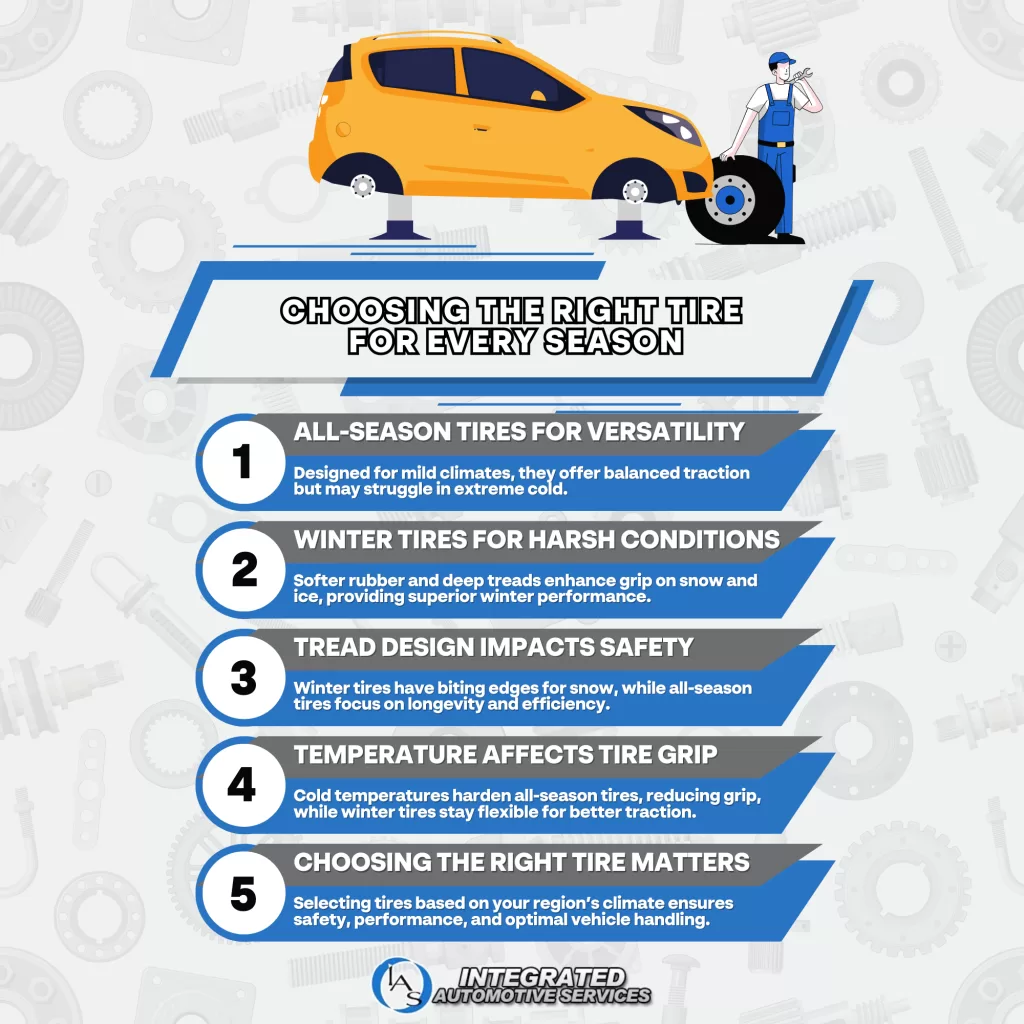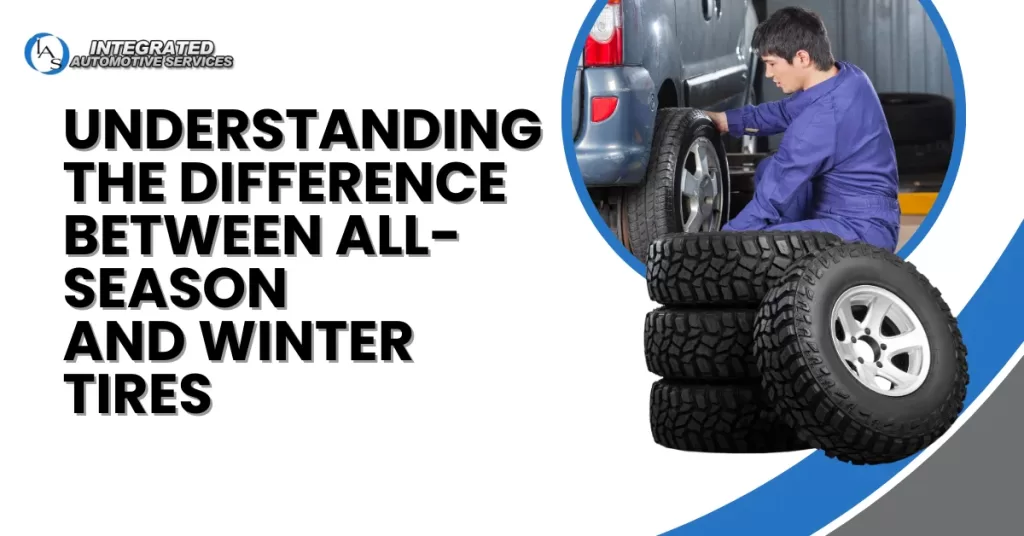Understanding the difference between all-season and winter tires is vital for your safety. All-season tires work well in mild conditions but struggle in extreme cold, thanks to their harder rubber and shallower treads. In contrast, winter tires excel in snowy and icy conditions due to their deep treads and softer compounds. Choosing the right tire for the climate can enhance your driving experience. Keep going to discover more about how each type performs in different weather situations.

Key Takeaways
- All-season tires are versatile for mild climates, while winter tires are specifically designed for harsh winter conditions and extreme cold.
- Winter tires feature deeper treads and softer rubber for better traction on snow and ice compared to all-season tires.
- All-season tires work well above freezing temperatures but struggle in extreme cold and heavy snow.
- Choosing the right tire type based on climate is crucial for safety and optimal performance on the road.
- Misconceptions include the belief that all-season tires are suitable for extreme weather and that winter tires wear out faster; proper use can extend their lifespan.
The Key Differences Between All-Season and Winter Tires
When it comes to choosing tires, understanding the key differences between all-season and winter options is essential. The tread design plays a significant role in how well your tires perform in various conditions, while temperature resistance and rubber composition can impact your vehicle’s grip and handling. Knowing these factors can help you make an informed decision for your driving needs.
How Tread Design Affects Performance
Understanding how tread design affects performance can greatly enhance your driving experience, particularly when choosing between all-season and winter tires. All-season tires have a tread pattern designed for versatility, providing a balance between dry, wet, and light winter conditions. Their grooves are shallower and more continuous, which helps with stability and fuel efficiency. On the other hand, winter tires feature deeper treads with more aggressive patterns and biting edges, designed specifically to grip snow and ice. This design allows for better traction in harsh winter conditions. When selecting tires, consider how you drive and the typical weather in your area; the right tread design can considerably impact your safety and performance on the road.
Temperature Resistance and Rubber Composition
The temperature resistance and rubber composition of tires play an important role in their performance. When comparing winter tires vs all season, you’ll find that winter tires are made from a softer rubber compound designed to remain flexible in cold temperatures, providing better grip on icy and snowy roads. In contrast, all-season tires use a harder rubber that can become stiff in frigid conditions, compromising traction. This difference in composition allows winter tires to excel in severe winter conditions, while all-season tires are more versatile but may struggle in extreme weather. Choosing the right type for your climate is vital to guarantee safety and performance on the road. Be sure to take into account your driving conditions when making your selection.
When to Use All-Season vs. Winter Tires
When it comes to choosing between all-season and winter tires, knowing the right conditions is key. All-season tires work well in mild climates, but winter tires really shine when temperatures drop and snow or ice is present. Understanding how these tires perform in different weather will help you make the best decision for your safety and driving needs.
Best Conditions for All-Season Tires
While winter tires are designed for extreme conditions, all-season tires excel in moderate climates, making them a versatile choice for many drivers. If you’re considering the best all-season tires, you’ll want to use them under the following conditions:
- Mild winters – When temperatures stay above freezing.
- Moderate rain – They handle wet roads effectively without losing grip.
- Light snow – Suitable for occasional light snowfall, but not heavy accumulation.
- Year-round driving – Ideal for those who drive in varying conditions without extreme weather.
These tires provide a balanced performance, ensuring your vehicle remains safe and reliable throughout the year. So, if you live in an area with moderate weather, all-season tires could be the right fit for you.
Why Winter Tires Excel in Cold Climates
All-season tires work well in moderate conditions, but their performance can falter as temperatures drop. When winter hits and temperatures consistently dip below 7°C (45°F), winter tires truly shine. Designed with softer rubber compounds, these tires remain flexible in the cold, ensuring better traction and grip on slippery surfaces. Their unique tread patterns are optimized for snow and ice, allowing you to navigate harsh conditions with confidence. If you live in an area where winters are long and harsh, investing in winter tires is essential for safety and performance. They provide the peace of mind you need when facing unpredictable weather, making your driving experience smoother and more secure during those chilly months.
The Impact of Snow, Ice, and Slush on Tire Grip
Driving in winter conditions can be challenging, especially when dealing with snow, ice, and slush, which greatly impact tire grip. Choosing the right tire can make a significant difference in your safety and performance. Here’s how snow, ice, and slush affect your tires:
- Snow: All-season tires in snow can struggle, causing reduced traction and longer stopping distances.
- Ice: The hard rubber compound of all-season tires often fails to grip icy surfaces effectively.
- Slush: Water mixed with snow can create slushy conditions, leading to hydroplaning with inadequate tires.
- Temperature: Cold temperatures can harden all-season tires, further diminishing their grip.
For peak performance, consider switching to winter tires when facing these conditions to guarantee better control and safety on the road.
Common Misconceptions About Tire Performance
You might think all-season tires can handle any weather, but that’s not always the case. Plus, there’s a common belief that winter tires wear out faster, which isn’t necessarily true. Let’s clear up these misconceptions so you can make the best choice for your driving needs.
Are All-Season Tires Truly Suitable for All Weather?
When reflecting on tire options, one might wonder if all-season tires are truly equipped to handle every weather condition. While they’re designed to perform well in various climates, they can’t always compete with winter tires in severe conditions. Here are some points to reflect on:
- Temperature Sensitivity: All-season tires lose grip in extreme cold.
- Snow Performance: They provide limited traction on snow and ice compared to winter tires.
- Tread Design: All-season tires have a different tread pattern, which may compromise performance in heavy rain.
- Wear and Tear: They can wear out faster under harsher conditions.
Ultimately, when weighing all-season vs winter tires, it’s clear that all-season tires have limitations if you frequently navigate extreme weather.
Do Winter Tires Wear Out Faster?
While many believe that winter tires wear out faster than all-season options, this isn’t always the case. The truth is, the rate at which winter tires wear out depends on several factors, including driving habits and road conditions. If you primarily drive in snowy or icy conditions, winter tires can actually last longer because they provide better grip, reducing the need for hard braking or rapid acceleration. However, if you use winter tires on dry, warm pavement, they may wear out faster due to their softer rubber compounds. So, it’s important to use winter tires in the right conditions and switch back to all-season tires when the weather permits, ensuring you get the most out of your investment without unnecessary wear.
Frequently Asked Questions
Can I Mix All-Season and Winter Tires on My Vehicle?
You shouldn’t mix all-season and winter tires on your vehicle. Doing so can compromise handling, safety, and traction, especially in adverse conditions. It’s best to use a consistent set of tires designed for your driving needs.
How Do Tire Tread Patterns Affect Performance?
Tire tread patterns greatly impact performance by influencing traction, handling, and stability. If you choose a design suited for your driving conditions, you’ll enhance your vehicle’s grip, especially during rain or snow.
Do Winter Tires Wear Faster in Warm Weather?
Picture driving on a sunlit road; winter tires can wear faster in warm weather. Their softer rubber compounds, designed for cold, grip the pavement less effectively, leading to quicker degradation. You’ll want to switch as temperatures rise.
Are There Specific Brands Recommended for Winter Tires?
When choosing winter tires, brands like Michelin, Bridgestone, and Goodyear are often recommended. They offer excellent traction and performance in cold conditions, ensuring your safety and comfort during winter driving. Don’t compromise on quality!
How Often Should I Check My Tire Pressure?
It’s funny how often tire pressure’s overlooked, right? You should check it at least once a month, and always before long trips. Proper pressure keeps your vehicle safe and enhances fuel efficiency—don’t neglect it!
Conclusion
When it comes to your safety on the road, you can’t afford to cut corners. Choosing the right tires for the season makes all the difference in your vehicle’s performance. While all-season tires may seem like a good catch-all solution, winter tires are your best bet when the weather turns nasty. Don’t let misconceptions steer you wrong; invest in the right tires and enjoy peace of mind and better handling, no matter the conditions outside.



